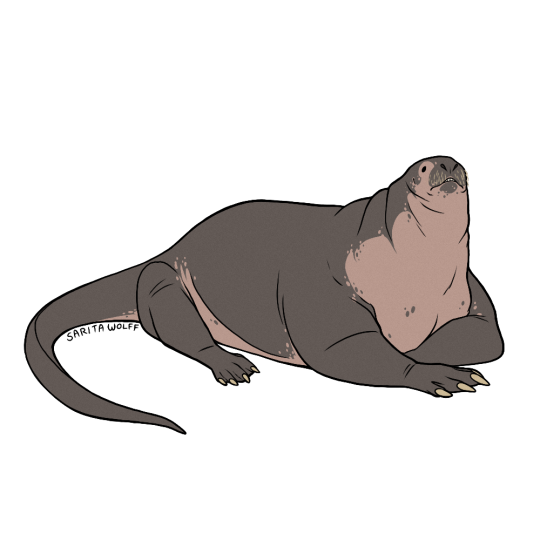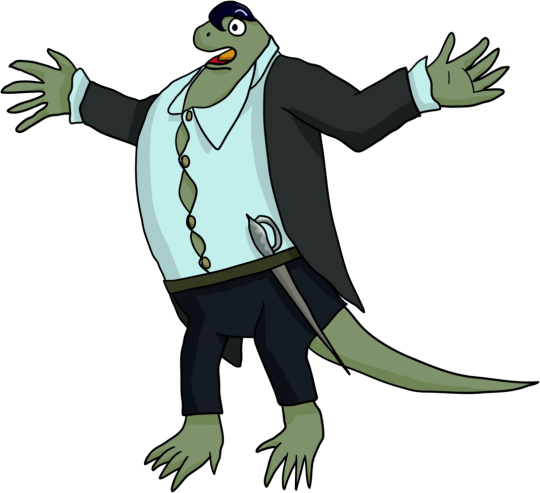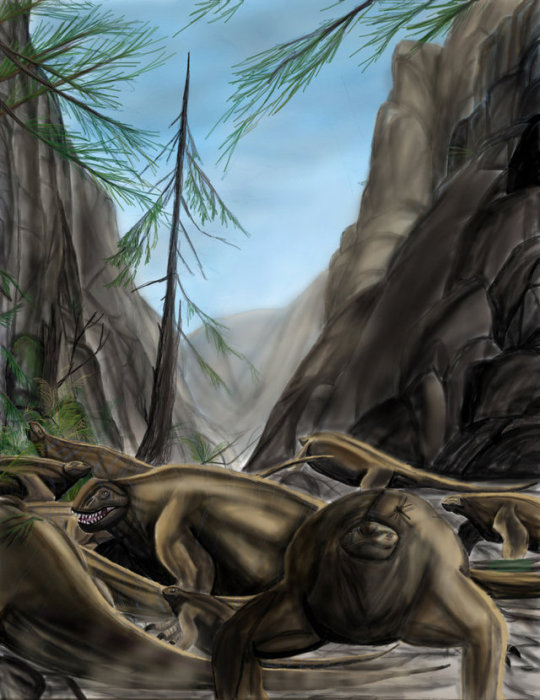#Cotylorhynchus hancocki
Text
"black cat girls" "golden retriever boys" what about us cotylorhynchus girls?

Cotylorhynchus is an extinct genus of herbivorous caseid synapsids that lived during the late Lower Permian (Kungurian) and possibly the early Middle Permian (Roadian) in what is now Texas and Oklahoma in the United States. The large number of specimens found make it the best-known caseid. Like all large herbivorous caseids, Cotylorhynchus had a short snout sloping forward and very large external nares. The head was very small compared to the size of the body. The latter was massive, barrel-shaped, and ended with a long tail. The limbs were short and robust. The hands and feet had short, broad fingers with powerful claws. The barrel-shaped body must have housed large intestines, suggesting that the animal had to feed on a large quantity of plants of low nutritional value. Caseids are generally considered to be terrestrial, though a semi-aquatic lifestyle has been proposed by some authors. The skull of Cotylorhynchus shows the typical caseid morphology with a forward sloping snout, very large nasal opening, a skull roof with numerous small depressions, and a very large pineal foramen. The latter is wider than long as in Ennatosaurus and thus differs from that of Euromycter which is subcircular.[2] The number of teeth in the upper and lower jaws ranges from 16 to 20. In the upper jaw, the anterior teeth are long and slender, while those behind decrease in size posteriorly and are slightly spatulate. All the marginal teeth have their distal end slightly inclined towards the interior of the mouth and the top of their crown each have three small cuspules arranged longitudinally. These teeth also show an enlargement of the central part of the crown.[3] In the lower jaw, the anterior teeth, not denticulate according to Olson, are shorter and tilt slightly forward. Other lower teeth are similar to those in the upper jaw. The postcranial skeleton is massive. The ribs are very long, heavy and curved to form a bulbous body. Ribs are present on all the pre-sacral vertebrae and the first caudal vertebrae. The five posterior presacral ribs are fused with the transverse processes of the vertebrae. The sacrum contains three vertebrae. The neural spines of larger specimens become proportionately taller, especially in the pelvic region. The limbs are short and strong. The femur is characterized by its proximal end having a broad shelf marked by a margin slightly overhanging the dorsal surface of the femur. The pes and manus are broad and short, and terminate in strong, sharp, and curved ungual phalanges which must have supported powerful claws. Muscle and tendon scars are very developed.[3]The genus Cotylorhynchus is represented by three species, the largest of which could reach more than 6 m in length. However, a study published in 2022 suggests that the genus may be paraphyletic, with two of the three species possibly belonging to separate genera. The genus name Cotylorhynchus comes from the Greek kotyle, cup, hollow, and rhynchos, beak, or snout. The genus was named so because of the nasal opening which is surrounded by a depressed, cup-shaped bony surface.[1] The genus Cotylorhynchus contains three species which differ in size and proportion, C. romeri (the type species), C. hancocki, and C. bransoni. In C. romeri there are two size groups which presumably represent sexual dimorphism. There is no size overlap between adults of C. romeri and C. hancocki, but larger specimens of C. bransoni have roughly the same dimensions as smaller specimens of C. romeri.[3] In 2022, Werneburg and colleagues suggested that the species C. hancocki and C. bransoni might not belong to the genus Cotylorhynchus. These authors consider that a detailed revision of these two taxa is necessary to clarify their status.[4]
187 notes
·
View notes
Text

(I’m going to be drawing some Non-mammalian synapsids in my usual simplified “Archovember” style, just to maintain it and also so when November comes around again it doesn’t take all my followers on Instagram by surprise when my feed suddenly becomes all dinosaur all the time. 😅)
For my first Non-mammalian synapsid, I chose Cotylorhynchus, specifically Cotylorhynchus hancocki, the Big One. (Yea this is the first non-mammalian synapsid I’ve drawn. Ever. I’ve never even drawn dimetrodon) I had to draw Cotylorhynchus because it just makes me laugh every time I’m reminded of its existence. It’s so ridiculous.
The whiskers are of course speculative but I was going with a walrus approach. Every reconstruction of Cotylorhynchus I’ve seen looks like that one first taxidermy of a walrus where the taxidermist didn’t know they were supposed to have wrinkles and smoothed the skin out. So I made him a bit wrinkly and gave him whiskers just to drive the point home. Still looks like an awful pile of flesh but, hey, that’s Cotylorhynchus.
54 notes
·
View notes
Photo

It’s been way too long since I last posted here—I had a big project I needed to finish, and then, well, things have been crazy the last few weeks for obvious reasons—but here’s another character from that project I’d been posting about.
If his proportions look really weird and his head looks ridiculously small, it’s mostly because he’s based on a real kind of prehistoric creature that had really weird proportions and a ridiculously small head.
I did mess up his coat, though. Oh well. And his feet, now that I look at them. Dang.
#The Very High Seas#character design#character#animation#pelycosaur#cotylorhynchus#Cotylorhynchus hancocki#Hancock
0 notes

